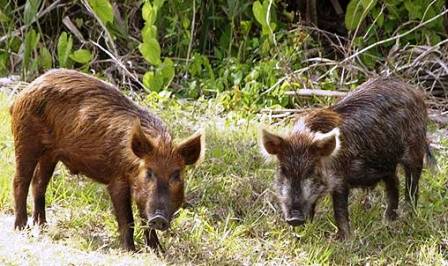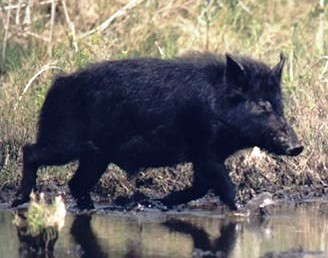Discover Florida Nature
It's time to explore the natural Florida


|
|
|
|
|
 Florida's
wild hogs are often referred to as feral hogs or swine and are of three
general types. These include free-ranging swine that come from
domesticated stock, Eurasian wild boar, and hybrids of the two. Although
technically, feral refers to free-ranging animals from domesticated
stock, all wild hogs are typically referred to as feral in Florida and
all are considered the same species, Sus scrofa. Florida's
wild hogs are often referred to as feral hogs or swine and are of three
general types. These include free-ranging swine that come from
domesticated stock, Eurasian wild boar, and hybrids of the two. Although
technically, feral refers to free-ranging animals from domesticated
stock, all wild hogs are typically referred to as feral in Florida and
all are considered the same species, Sus scrofa. It is believed that hogs were first brought to Florida, and possibly the U.S., in 1539, when Hernando de Soto brought swine to provision a settlement he established at Charlotte Harbor in Lee County. However, it is possible that hogs had been brought to the same site in 1521 by Ponce de Leon during a brief visit. During the next 4 centuries, explorers and settlers brought pigs with them throughout Florida. Many of these animals were given to or stolen by Native Americans who expanded pig numbers and distribution in the State. Europeans and Native Americans alike often raised their swine in semi-wild conditions (at least until the mid-1900s when open range ended and it became illegal) where hogs were allowed to roam freely and only rounded up when needed. Many of these animals and those escaping from captivity established feral populations throughout Florida. Wild hogs are now found in every county in Florida and in at least 35 states and Canadian provinces, including most of the Southeast. Florida, second only to Texas, is estimated to have 500,000+ wild hogs in a relatively stable population, with 1 to 2 million in the Southeastern U.S. Hogs use a variety of habitat types in Florida, from flatwoods, upland pine, and bottomland hardwood forests to coastal areas, marshes, swamps, and more open agricultural lands. However, hogs prefer large forested areas with abundant food, particularly acorns, interspersed with marshes, hammocks, ponds, and drainages; cover in the form of dense brush; and limited human disturbance. Dense cover is used as bedding areas and provides protection from predators and hunters All wild hogs are hoofed mammals, stocky with relatively short legs, long snouts ending in a disk, and long canine teeth that appear as tusks. Feral hogs resemble domestic hogs, but are usually leaner and have developed different behaviors that promote survival in the wild. Feral hogs typically have solid-colored, black, white, and/or reddish-brown hair either in solid or mottled patterns across the body.  Typically,
male hogs (called boars) are larger than females (called sows). Average
adult males may weigh 200+ pounds, stand 3 feet at the shoulder, have
tails reaching 12 inches, and are almost 5 feet from the tip of the tail
to the tip of the snout. However, males greater than twice this size
have been recorded. Hogs have 4 continually growing, self-sharpening
tusks (2 in the upper and 2 in the lower jaw; the rubbing of upper and
lower tusks keeps them sharp). Tusks in females are relatively small,
while in males they become quite pronounced and have trophy value. Typically,
male hogs (called boars) are larger than females (called sows). Average
adult males may weigh 200+ pounds, stand 3 feet at the shoulder, have
tails reaching 12 inches, and are almost 5 feet from the tip of the tail
to the tip of the snout. However, males greater than twice this size
have been recorded. Hogs have 4 continually growing, self-sharpening
tusks (2 in the upper and 2 in the lower jaw; the rubbing of upper and
lower tusks keeps them sharp). Tusks in females are relatively small,
while in males they become quite pronounced and have trophy value. All wild hogs have an excellent sense of smell and good hearing, but relatively poor vision. Wild hogs use a variety of vocalizations, including an alarm grunt given by the first hog to sense an intruder that causes a flight response by the rest of the herd. Other vocalizations are similar to domesticated pigs. Wild hogs also communicate through scent posts that are often also used for body-scratching and rubbing. Boars also “tusk” small trees, frequently pines, scraping off the outside bark with their tusks. This behavior may play a part in some type of dominance display. Such actions can seriously damage the rubbed objects, often trees Wild hogs are omnivorous, opportunistic feeders. However, they consume far more plant than animal material, and may occasionally consume carrion. The list of foods eaten by hogs is diverse and includes grass, forb, and woody plant stems, roots, tubers, leaves, seeds, and fruits, fungi, and a variety of animals including worms, insects, crustaceans, mollusks, fish, small birds, mammals, reptiles, and amphibians. The opportunistic tendencies of wild hogs often lead them to forage in agricultural lands and forest plantations where they can cause significant losses of crops. In Florida, wild hogs breed year round with peaks in the breeding cycle during fall and spring. Breeding activity includes courtship behavior, males fighting to achieve dominance and access to mates, and copulation. With pregnancy lasting about 115 days, hogs can produce 2 litters of 5-7 piglets per year, although they sometimes have litters as large as 13 piglets. |
|
|
Advertise | Privacy Statement | Dog Encyclopedia | Video |Contact | Alaska Nature |
|